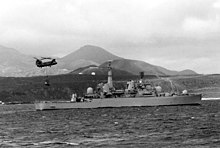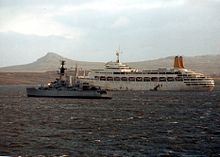| Revision as of 10:34, 12 August 2008 editWee Curry Monster (talk | contribs)Extended confirmed users, Pending changes reviewers, Rollbackers25,546 edits rv see talk page, an iconic image of the only nuclear submarine to sink a warship in a conflict, in a well know incident adds to understanding see talk page.← Previous edit | Revision as of 10:53, 12 August 2008 edit undoFuture Perfect at Sunrise (talk | contribs)Edit filter managers, Administrators87,210 edits rv, image *will* be deleted.Next edit → | ||
| Line 2: | Line 2: | ||
| ==]== | ==]== | ||
| ] after the war, flying the '']'' to signal her sinking of the ]]] | |||
| ;Command | ;Command | ||
| In Northwood, London<ref>{{cite book | In Northwood, London<ref>{{cite book | ||
Revision as of 10:53, 12 August 2008
This is a list of the naval forces from the United Kingdom that took part in the Falklands War. For a list of naval forces from Argentina, see Argentine Naval Forces in the Falklands War.
Royal Navy
- Command
In Northwood, London:
- Commander-in-Chief, Fleet: Admiral Sir John Fieldhouse
- Commander Task Group 324.3 and Flag Officer Submarines: Vice-Admiral Peter G. M. Herbert
In the South Atlantic:
- Commander Task Group 317.8 (Carrier/Battle Group) and Flag Officer, First Flotilla: Rear-Admiral J. 'Sandy' Woodward (HMS Hermes)
- Commander Task Group 317.0 (Amphibious Task Group) and Commodore Amphibious Warfare: Commodore M. Clapp (HMS Fearless)
- Supply force: Commodore S.C. Dunlop
- Centaur class aircraft carrier - V/STOL carrier
- HMS Hermes (R12) - Flagship (†3) 2 SHAR pilots
- Capt. L.E. Middleton
- HMS Invincible (R05) (†3) 2 SHAR pilots
- Capt. J.J. Black
- HMS Fearless (L10) (†6) from LCU Foxtrot Four
- Capt. E.S.L. Larken
- HMS Intrepid (L11)
- Capt. P.G.V. Dingemans

- HMS Bristol (D23)
- Capt. A. Grose
- HMS Sheffield (D80) - set on fire by a Aérospatiale AM39 Exocet (Air-to-Surface) Anti-ship missile launched from a Dassault Super Étendard May 4, (†20) - Fatal Damage (sank on May 10)
- Capt. S. Salt
- HMS Glasgow (D88) - hit by unexploded bomb from a Douglas A-4B Skyhawk May 12, withdrawn from war - Moderate Damage
- Capt. A.P. Hoddinott
- HMS Coventry (D118) - sunk on May 25 by three bombs from a Douglas A-4B Skyhawk (†19) - Fatal Damage
- Capt. D. Hart-Dyke
- HMS Exeter (D89)
- Capt. H.M. Balfour
- HMS Cardiff (D108)
- Capt. M.G.T. Harris
- HMS Glamorgan (D19) - hit by an Aérospatiale MM38 Exocet (Surface-to-Surface) Anti-ship missile on June 11 (†13) - Major Damage
- Capt. M.E. Barrow
- HMS Antrim (D18) - hit by unexploded bomb from a IAI Dagger - Major Damage
- Capt. B.G. Young
- HMS Brilliant (F90) - hit by IAI Dagger cannon fire - Minor Damage
- Capt. J.F. Coward
- HMS Broadsword (F88) - hit by IAI Dagger cannon fire, later damaged by bomb from Douglas A-4B Skyhawk - Moderate Damage
- Capt. W.R. Canning
- HMS Active (F171)
- Cdr. P.C.B. Canter
- HMS Alacrity (F174) - slightly damaged by bomb
- Cdr. C.J.S. Craig
- HMS Antelope (F170) - sank May 24 due to unsuccessful defusing attempt of unexploded bombs from Douglas A-4B Skyhawks (†2) - Fatal Damage
- Cdr. N. Tobin
- HMS Ardent (F184) - sank May 21 by bombs from IAI Daggers and Douglas A-4Q Skyhawks (†22) - Fatal Damage
- Cdr. A. West (Later Admiral Sir Alan West, First Sea Lord 2002 - 2006)
- HMS Ambuscade (F172)
- Cdr. P.J. Mosse
- HMS Avenger (F185)
- Capt. H.M. White
- HMS Arrow (F173) - hit by IAI Dagger cannon fire - Minor Damage
- Cdr. P.J. Bootherstone
- HMS Andromeda (F57)
- Capt. J. L. Weatherall
- HMS Argonaut (F56) - hit by Aermacchi MB.339A cannon/rocket and unexploded bombs from Douglas A-4B Skyhawks (†2) - Major Damage
- Capt. C.H. Layman
- HMS Minerva (F45)
- Cdr. S.H.G. Johnston
- HMS Penelope (F127)
- Cdr. P.V. Rickard
- HMS Yarmouth (F101)
- Cdr. A. Morton
- HMS Plymouth (F126) - unexploded bombs from IAI Daggers - Major Damage
- Capt. D. Pentreath
- Ice patrol ship

- HMS Endurance (A171)
- Capt. N.J. Barker
As despatch vessels, carrying mail between the Task Force and Ascension Island.
- HMS Conqueror (S84) - sank the ARA General Belgrano
- Cdr. C.L. Wreford-Brown
- HMS Courageous (S50)
- Cdr. R.T.N. Best
- HMS Onyx (S21) - ran aground - Moderate Damage
- Lt-Cdr. A. O. Johnson
- HMS Valiant (S102)
- Cdr. T.M. Le Marchand
- HMS Spartan (S105)
- Cdr. J.B. Taylor
- HMS Splendid (S106)
- Cdr. R.C. Lane-Nott
2,744 t, used as casualty ferries
- HMS Hecla (A133)
- G.L. Hope
- HMS Herald (H138)
- R.I.C. Halliday
- HMS Hydra (A144)
- R.J. Campbell
- Trawler/Minesweepers
Civilian trawlers converted to Extra-Deep Armed Team Sweep (EDATS) with acoustic and electro-magnetic tow. Manned by RNR personnel.
- HMS Cordella 1,238 t
- HMS Farnella 1,207 t
- HMS Junella 1,615 t
- HMS Northella 1,238 t
- HMS Pict 1,478 t
- All five minesweepers cleared two minefields in Port Stanley.
Royal Fleet Auxiliary
Tankers
- RFA Olna (A123) 36,000 t
- J.A. Bailey
- RFA Olmeda (A124) 36,000 t
- G.P. Overbury
- RFA Tidespring (A75) 27,400 t
- S. Redmond
- RFA Tidepool (A76) 27,400 t
- J.W. Gaffrey
- RFA Blue Rover (A270) 11,522 t
- D.A. Reynolds
- RFA Appleleaf (A79) 40,870 t
- G.P.A. McDougall
- RFA Brambleleaf (A81) 40,000 t
- M.S.J. Farley
- RFA Bayleaf (A109) 40,000 t
- A.E.T. Hunter
- RFA Plumleaf (A78) 25,790 t
- R.W.M. Wallace
- RFA Pearleaf (A77) 25,790 t
- J. McCulloch
Landing Ship Logistic
 |
- RFA Sir Bedivere (L3004) - bombed by Douglas A-4B Skyhawk - Minor Damage
- P.J. McCarthy
- RFA Sir Galahad (L3005) - bombed on May 24 and June 8 by Douglas A-4B Skyhawks (sunk by torpedo on June 21 as war grave) (†48) - Fatal Damage
- P.J.G. Roberts
- RFA Sir Geraint (L3027)
- D.E. Lawrence
- RFA Sir Lancelot (L3029) - damaged by unexploded bombs from Douglas A-4B Skyhawks
- C.A. Purtcher-Wydenbruck
- RFA Sir Percivale (L3036)
- A.F. Pitt
- RFA Sir Tristram (L3505) - bombed June 8 by Douglas A-4B Skyhawks (†2) - Major Damage
- G.R. Green
Supply Ships
- RFA Regent (A486) 22,890 t
- J. Logan
- RFA Resource (A480) 22,890 t
- B.A. Seymour
- RFA Fort Austin (A386) 23,600 t
- Cdre. S.C. Dunlop
- RFA Fort Grange (A385) 23,600 t
- D.G.M. Averill
- RFA Stromness (A344) 16,792 t - attacked by A-4C on May 24 - Minor Damage
- J.B. Dickinson
Helicopter Support Ship
- RFA Engadine (K08) 9,000 t
- D.F.Freeman
Royal Maritime Auxiliary Service
Ships Taken Up From Trade

The following Merchant Navy ships were requisitioned, as Ships Taken Up From Trade (STUFT).
- Liners
- SS Canberra 44,807 t — carried personnel of the 3rd Commando Brigade.
- RMS Queen Elizabeth 2. 67,107 t — carried personnel of the 5th Infantry Brigade.
- HMHS Uganda 16,907 t — hospital ship.
- Elk 5,463 t
- Baltic Ferry 6,455 t
- Europic Ferry 4,190 t
- Nordic Ferry 6,455 t
- Norland 12,990 t — carried 2 Para to San Carlos
- St Edmund 8,990 t
- Tor Caledonia 5,056 t
- Container / Cargo ships
File:Atlantic conveyor.jpg Atlantic Conveyor
- Atlantic Conveyor 14,496 t — sunk by one or two Aérospatiale AM39 Exocet Air-to-Surface Anti-ship missile(s) launched from a Dassault Super Étendard (†12) - Fatal Damage
- Atlantic Causeway 14,946 t — carried ASW Sea Kings
- Contender Bezant 11,000 t — purchased as RFA Argus post-war
- Geestport 7,730 t
- Laertes 11,804 t
- Lycaon 11,804 t
- Saxonia 12,029 t
- St. Helena 3,150 t — minesweeper support ship
- Tankers
- Alvega 33,000 t
- Anco Charger 25,300 t
- Balder London 19,980 t
- British Avon 15,640 t
- British Dart 15,650 t
- British Esk 15,643 t
- British Tamar 15,646 t
- British Tay 15,650 t
- British Test 16,653 t
- British Trent 15,649 t
- British Wye 15,649 t — hit by bomb from Lockheed C-130 Hercules - Minor Damage
- Eburna 19,763 t
- Fort Toronto 31,745 t — fresh water tanker
- G.A.Walker 18,744 t
- Scottish Eagle 33,000 t
- Tugs / Repair / Support Ships
- British Enterprise III 1,595 t — diving support ship
- CS Iris 3,873 t — cable ship as despatch vessel
- Irishman 686 t — ocean tug
- Salvageman 1,598 t — ocean tug
- Stena Inspector 7,000 t — purchased as RFA Diligence post-war
- Stena Seaspread 6,061 t — oilfield support ship
- Wimpey Seahorse 1,599 t — oilfield supply vessel
- Yorkshireman 686 t — ocean tug
Weaponry


- Torpedoes
- Mark 24 Tigerfish torpedo
- Mark 8 torpedo
References
- Sir Lawrence Freeman (2005). The Official History of the Falkands Campaign. Routledge. ISBN 0-7146-5207-5.
- Antony Preston: Sea combat off the Falklands, 1982, Willow Books, ISBN 0-00-218046-4
- Ward, Sharkey (1992). Sea Harrier over the Falklands. Cassell Military Paperbacks. p. 271. ISBN 0-304-35542-9.
- "British Railways - Sealink".
- Hastings, Max (1983). The Battle for the Falklands. Michael Joseph Ltd. ISBN 0-7181-2228-3.
{{cite book}}: Unknown parameter|coauthors=ignored (|author=suggested) (help) - Puddefoot, Geoff (2007). No Sea Too Rough. Chatam Publishing. ISBN 97-1-86176-314-3.
{{cite book}}: Check|isbn=value: length (help) - Clapp, Michael (1996). Amphibious Assault Falklands. Leo Cooper. ISBN 0-85052-420-2.
{{cite book}}: Unknown parameter|coauthors=ignored (|author=suggested) (help)
External links
- Ships of the Royal Navy - Royal Fleet Auxiliary - Merchant Navy
| Falklands War | |
|---|---|
| Timeline | |
| Battles | |
| Operations | |
| Forces | |
| Ships | |
| Related | |